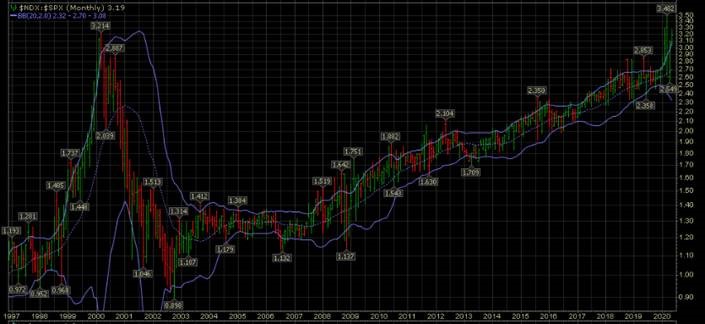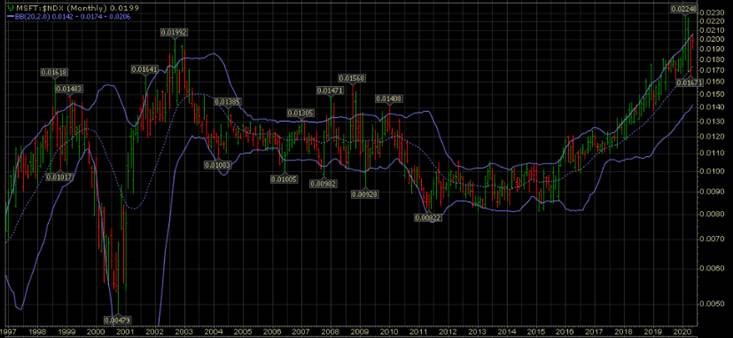On May 15th, 1997, Amazon became a public company at a price of $18/share. $10,000 of seed capital invested in 1997 would have grown to $12 million as of May 2020. This example highlights the power of secular growth. Rather than trying to time the markets, or be tactical in the investment strategy, a longterm, consistent, returns-focused strategy would have yielded the best results. This is what we strive to do in our investment practice, identifying long term secular winners that have a long runway for growth and a long time horizon to execute. This is what powers the ‘Amazons’ of the world. Indeed, Amazon owneroperator Jeff Bezos even followed a similar playbook, re-investing back into its cloud enterprise even when the shares appeared to trade at an all-time high, which explains the company’s continued ascent. Mr. Bezos had the vision to identify winner take all effects in what would become a highly lucrative, duopolistic market, transforming a retail-led strategy into a digital behemoth. LVMH is another example, with its recent purchase of Tiffany, diversifying the company in the lucrative, mostly American jewelry market. The key message is that a long time horizon yields the best results, because the secular growth characteristics have the time to compound into financial results that leads to sustained, and even accelerated earnings growth. As we know from previous installments, markets are driven off earnings power. The higher the earnings power, the higher the company’s shares.
A second topic we would like to highlight is that secular growth itself is oftentimes the best defense against volatile markets. Markets, as we have learned, contain a wide spectrum of investments from fixed income and GIC instruments to growth equities, which we mainly specialize in. Within growth equities, there are areas of the market that remain defensively oriented, with strong enough business models to weather storms and outperform. In the most recent Coronavirus event, top secular growers, most of which are part of the Nasdaq 100, continued their record of outperformance versus the S&P500, even amidst the worst days of the downturn (Image 1). This is because the companies in this group exhibit strong recurring revenue profiles and fortress balance sheets that enable them to survive and prosper in a post COVID-19 world. Below, we explore three of our secular growth investments that weathered the most recent storm well.
Image 1: Nasdaq 100 versus the S&P500

First, with the shift to remote teleworking for most business professionals, there has been an organizational surge in demand for cloud computing and the associated infrastructure needed to support a more agile organization. As a result, companies that have invested in the past in building a unique and trusted value proposition for cloud users are at a significant advantage. This leads to one of the core tenets of our investment program, which is to have a long time horizon so that these secular growth themes can be realized in companies’ financials, and therefore recognized in the stock price. Microsoft is one such example of a stock that is benefiting in a post COVID-19 world. Even prior to the downturn, the company was leading a theme of digital migration and transformation within client organizations. The company’s main platform for doing this, Azure, grew by almost 60%, even in the heart of the downturn. Readers may think of cloud computing like paying rent. In the technology sector, this is called “software as a service” (SAAS). Because SAAS payments are recurring, they tend to be more resilient and insulated from market forces. In this case, they even benefited from new demand as organizations migrated to a “remote-from-home” working environment. On the flipside, when markets recover, clients demand more innovation to meet their digitization objectives, leading to further growth in the recurring annuity stream. Microsoft, as can be seen in image 2, has not only outperformed the S&P500, but has outperformed its peer group of secular Nasdaq 100 growers.
Image 2: Microsoft versus the Nasdaq 100

A second example of an industry with a defensible moat is digital advertising. The difference between digital advertising and mass media (i.e. television) is that digital advertising is measurable, providing advertisers with a direct line of sight into the return on investment of specific campaigns, so that the customer response can be gauged and then modified, if necessary. Because of the measurable nature of digital advertising, it is easily turned off and turned back on when economic conditions improve. Both FaceBook and Alphabet, two of the digital advertisers we own, cited this phenomenon and noted that in the first few weeks of April, ad trends actually stabilized. This gives investors comfort that when consumer activity resumes again, advertising, one of the most GDP sensitive areas, will be the first to rebound. In addition, FaceBook noted a 10% surge in monthly active users, a testament to how valuable their platform is during uncertain times.
The final example is NVIDIA. As readers will know from past instalments, the chip industry is an emerging secular growth area, because of the increasing complexity of devices, the need for faster data transmissions and associated storage, and greater processing speeds to meet the demands of new content. The usage of semiconductors is also expanding across gaming, the medical field, cloud computing, personal devices, and so forth. NVIDIA is a semiconductor company that benefits as the medical field requires intensive processing power to sequence DNA, a key input into the development of diagnosis tools and an eventual cure or vaccine for the Coronavirus. The company’s semiconductors (GPUs) have a wide range of functionality, ranging from gaming to cloud storage, and now medical applications. We added to NVIDIA throughout the downturn, and it has now become one of our larger positions that have added value to client investment accounts.
We hope these insights are informative and we wish everyone well until our next interaction!
Best regards,
Grace, Sam, Leslie and Jennifer
